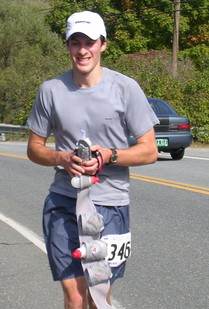 Refilling bottles at Vermont 50
Refilling bottles at Vermont 50 I used to carry water with me on nearly every run. I might do that again when training for a specific race where I'll need to carry a lot of weight, but these days I only bring water on runs that are about 90 minutes or longer. Same goes for calories.
When racing or training hard I like to drink about 20oz of fluid and consume about 200 calories per hour. I'll modify this plan as needed, for example in hot or humid weather I'll drink more, and in the later hours of an ultra or long mountain run I'll often eat more.
On the other hand, during easy long runs I like to eat and drink less than I "need" in order to teach my body to perform when deprived of calories or even fluids. Of course this needs to be done carefully, and I'm always quick to rehydrate and refuel after the run.
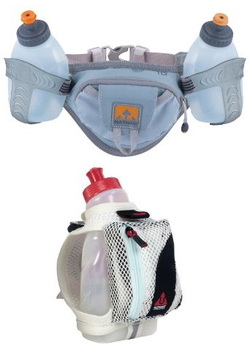 Long Road Run Kit
Long Road Run Kit This works well for me because when running on the road I don't like too much weight in my hands as it affects the arm swing, so the 10oz handheld is a much better choice than a 22oz. And I don't mind waist belts on the road as my running is smoother and bounce is less of an issue.
With 30oz of water I can run for about 3hrs, which is the longest I ever do on the road. It's less water than I should be drinking over 3hrs, but again I don't mind getting by with less so that my body learns to more effectively utilize fluids in races. Note that on a hot day or when doing a fast-paced long run I would need more, and would find a way to stash water or swing by a place where I could refill.
For fuel I'll either mix Gatorade powder into my water or carry a few gels in the waist belt. Again, I try not to eat too much on my long runs unless I'm pushing the pace so that my body learns to run without optimal fueling.
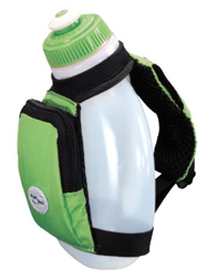 Marathon or Short Race Kit
Marathon or Short Race Kit My ideal marathon hydration/fueling strategy involves carrying one 10oz handheld and swapping it out for a full one every half-hour or so (which means I own two). That means my support crew (my wife at the GMAA marathon last fall) has to be able to access points along the entire course, ideally every four or five miles. The bottle is filled with water, one GU and some Gatorade powder to give it a nicer flavor (and a few more calories and electrolytes). So I take in somewhere around 20oz of fluids, with about 250 calories and some salt every hour. If it's cool out I might not finish each bottle, and if it's hot I'll supplement with water or sports drink from the aid stations.
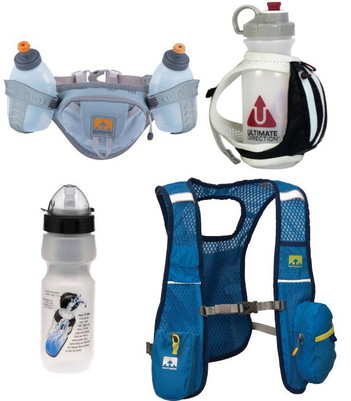 Long Trail Run Options (if water sources are plentiful)
Long Trail Run Options (if water sources are plentiful) Since I can't put gel or powder into the filter bottle I need a way to carry my fuel, as well. The handheld strap has a small pocket, so I'll stuff some food in there for quick access. Depending on the run I might go with a 10oz handheld or a race vest or waist pack for additional fuel.
The 10oz handheld can be filled with GU (diluted a bit with water to make it more drinkable) and also has a small pocket for more food. This was the strategy I used at the Wakely Dam Ultra in 2013, and I was able to carry just enough food for 5hrs with just the two handhelds and their small pockets.
If I need or want more food I'll bring either a race vest, which has two large pockets in front that I can fill with a gel flask, bars and other snacks, or a waist belt, which has a one large pocket for solid food as well as two 10oz flasks for diluted GU. I prefer not to carry the belt when trail running, as I find bounce to be more of an issue because the belt rides up onto my waist.
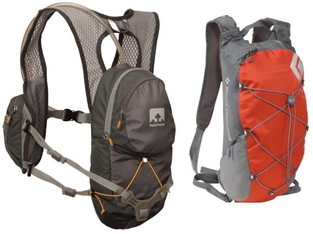 Long Trail Run Options (if water is scarce)
Long Trail Run Options (if water is scarce) I have two options for these types of runs, a pack and a vest. Either would be fine, but I usually choose the vest if I value the convenience of having access to all my food at all times (i.e. going for a fastest known time and not wanting to stop), or the pack if I want the comfort of simple shoulder straps on my chest rather than all the vest material (especially if I'm not wearing a shirt).
I use a 2L bladder in both, and find I can get 3-4hrs out of 70oz of water without much trouble. I've never been on a route where I didn't have a chance to fill up at this point in the run. When it's time to fill I take the pack off, remove the bladder, fill it, and treat it with Katadyn Micropur (although I often don't treat if the source is high and clear).
Food is obviously not an issue, as both options have plenty of storage space for all the calories I'd need for a day. Generally I'll stick with fast calories like GU, Clif Bloks and bars, but often will include something more solid like a sandwich since the mountains can make you bonk on a completely different level! I can also fit a jacket, gloves and hat if it's cold, and other important items for being out in the mountains, so there's a good reason to have the space even if I didn't need it to carry all that water.
My Favorite Gear
10oz Handheld: Ultimate Direction Fastdraw 10oz (strap and bottle are great this time)
Waist Belt: Nathan Trail Mix
Race Vest: Nathan HPL 028
Filter Bottle: Bota Outback; Clearbrook; Pristine (mine is Bota but it's not made anymore. Pristine might be Canada only)
Hydration Vest: Nathan HPL 020
Hydration Pack: Black Diamond Flash (doesn't come with bladder. I use a Platypus Hoser 2L)
If you buy this stuff using these links I get some money from Amazon. But it's better if you can search out a specialty retailer and buy it from them. The Mountaineer in Keene Valley carries almost all of this gear, for example, and you'd be supporting a local business and getting to check the gear out in person before buying it.
 RSS Feed
RSS Feed
